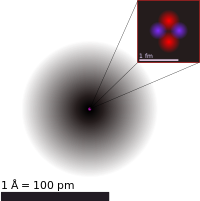
Back परमाणु सिद्धांत ANP نظرية ذرية Arabic Teoría atómica AST Атамная тэорыя Byelorussian Атомна теория Bulgarian পারমাণবিক তত্ত্ব Bengali/Bangla Atomska teorija BS Teoria atòmica Catalan تیۆریی ئەتۆمی CKB Atomová teorie Czech

Atomic theory is the scientific theory that matter is composed of particles called atoms. The definition of the word "atom" has changed over the years in response to scientific discoveries. Initially, it referred to a hypothetical concept of there being some fundamental particle of matter, too small to be seen by the naked eye, that could not be divided. Then the definition was refined to being the basic particles of the chemical elements, when chemists observed that elements seemed to combine with each other in ratios of small whole numbers. Then physicists discovered that these particles had an internal structure of their own and therefore perhaps did not deserve to be called "atoms", but renaming atoms would have been impractical by that point.
Atomic theory is one of the most important scientific developments in history. At the start of The Feynman Lectures on Physics, physicist and Nobel laureate Richard Feynman offers the atomic hypothesis as the single most prolific scientific concept.[1]
- ^ Feynman, Leighton & Sands 1963, p. I-2 "If, in some cataclysm, all [] scientific knowledge were to be destroyed [save] one sentence [...] what statement would contain the most information in the fewest words? I believe it is [...] that all things are made up of atoms – little particles that move around in perpetual motion, attracting each other when they are a little distance apart, but repelling upon being squeezed into one another ..."